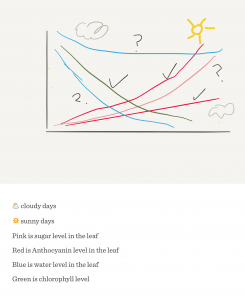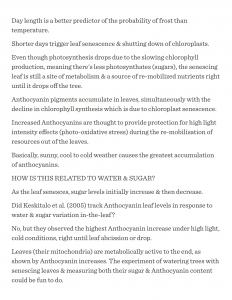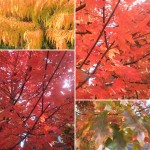 Who can resist being entranced by the gorgeous Fall colours around us? I find them distracting, even as Canada's science and sustainability communities have been focussed on much more weighty issues of a general election and Ada Lovelace Day, a celebration of Women in STEM.
Who can resist being entranced by the gorgeous Fall colours around us? I find them distracting, even as Canada's science and sustainability communities have been focussed on much more weighty issues of a general election and Ada Lovelace Day, a celebration of Women in STEM.
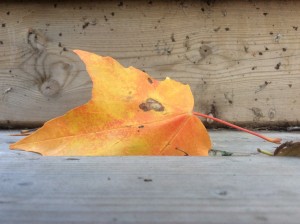 In the midst of the latter socially important stuff, I couldn't help tweeting about the chemistry of autumn leaves - this has been an exceptionally good year for colours, with lots of:
In the midst of the latter socially important stuff, I couldn't help tweeting about the chemistry of autumn leaves - this has been an exceptionally good year for colours, with lots of:
- sunny days.
- cool nights.
- not too much wind and rain to shake the trees bare of leaves.
Awesome? Yes! I even learned that European (mostly yellow) and North American (red) fall colours are different, and theories about why this is the case.
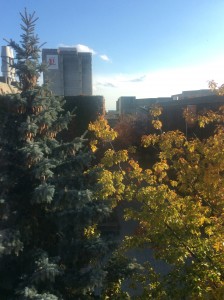 BUT, then I got a tweet asking me to clarify something about the biochemistry of the changing leaf colours as they were explained in a very detailed online article from the cool "science is fun" website of University of Wisconsin-Madison Chemistry Professor Bassam Z. Shakhashiri.
BUT, then I got a tweet asking me to clarify something about the biochemistry of the changing leaf colours as they were explained in a very detailed online article from the cool "science is fun" website of University of Wisconsin-Madison Chemistry Professor Bassam Z. Shakhashiri.
That's easy, I thought. But, after looking at 3 ecology text books, a plant sciences text and Vogel's The Life of the Leaf, I haven't answered the question satisfactorily for myself: namely, what is driving the elevated sugar concentrations in the leaf? Is it solely reduced water uptake from the roots to the leaves, or do increased leaf sugar levels occur because metabolic processes that use sugar from photosynthesis have slowed down with cooler temperatures? It turns out that the nitty gritty of leaf colour biochemistry isn't covered in detail in undergraduate text books. Interesting.
@dawnbazely why [sugar] inc in fall? Is because [water] dec? If so, y? #helpfroggieunderstandscience https://t.co/pDFIP3VXk4
— Froggie Fancypants (@Notfroggie) October 23, 2015
Here's the key info from Prof. Shakhashiri's science is fun article "Anthocyanins are formed by a reaction between sugars and certain proteins in cell sap. This reaction does not occur until the concentration of sugar in the sap is quite high." This prompted the question of how the sugar concentrations increase. And, a twitter conversation.
@may_gun @Notfroggie, Tnx, Megan. 🐸 was wondering about leaf anthocyanin levels. I'll have to look up the answer. — Dawn Bazely (@dawnbazely) October 24, 2015
Again, from the article: "The shortening days and cool nights of autumn trigger changes in the tree. One of these changes is the growth of a corky membrane between the branch and the leaf stem. This membrane interferes with the flow of nutrients into the leaf. Because the nutrient flow is interrupted, the production of chlorophyll in the leaf declines, and the green color of the leaf fades."
@dawnbazely yah but both that and compound chem say anthocyanin inc when sugar inc. IDGIT. I get chlor drop
— Froggie Fancypants (@Notfroggie) October 23, 2015
And, "The range and intensity of autumn colors is greatly influenced by the weather. Low temperatures destroy chlorophyll, and if they stay above freezing, promote the formation of anthocyanins. Bright sunshine also destroys chlorophyll and enhances anthocyanin production. Dry weather, by increasing sugar concentration in sap, also increases the amount of anthocyanin."
I need to check the primary research literature to find the causes and patterns of how sugar concentrations and water content of leaves vary over the Fall, depending on whether the weather is wet or dry. So far, I read it as, under sunnier, drier conditions, there is less water getting into the leaf from the roots, which causes sugar levels to become more concentrated. Additionally, sugars are likely piling up because of the reduced flow of nutrients into the leaf (corky barrier). But, I haven't found the data for this... just yet.
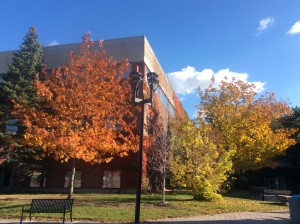 Luckily, Prof. Shakhashiri's great science of autumn colours article gives me some primary sources to check:
Luckily, Prof. Shakhashiri's great science of autumn colours article gives me some primary sources to check:
REFERENCES
“The Colors of Autumn Leaves as Symptoms of Cellular Recycling and Defenses Against Environmental
Stresses,” Helen J. Ougham, Phillip Morris, and Howard Thomas, Current Topics in Developmental Biology,
2005, Vol. 66, pp. 135-160.
“A Cellular Timetable of Autumn Senescence,” Johanna Keskitalo, Gustaf Bergquist, Per Gardenström, and
Stefan Jansson, Plant Physiology, August 2005, Vol. 130, pp. 1635-1648.
ADDITIONAL READING
Climate-warmed leaves change lake ecosystems, Dartmouth-led study finds
http://www.eurekalert.org/pub_releases/2015-02/dc-clc022515.php
Thank you @NotFroggie @may_gun, and Twitter.
UPDATE: I read Keskitalo et al. 2005, @NotFroggie, and made these notes and a sketch. Although they don't present data on water uptake into the leaf in relation to sunny and cloudy days, or on how sugar content varies in relation to cloud cover, it appears that anthocyanin is really driven by sun. I hope this helps.

